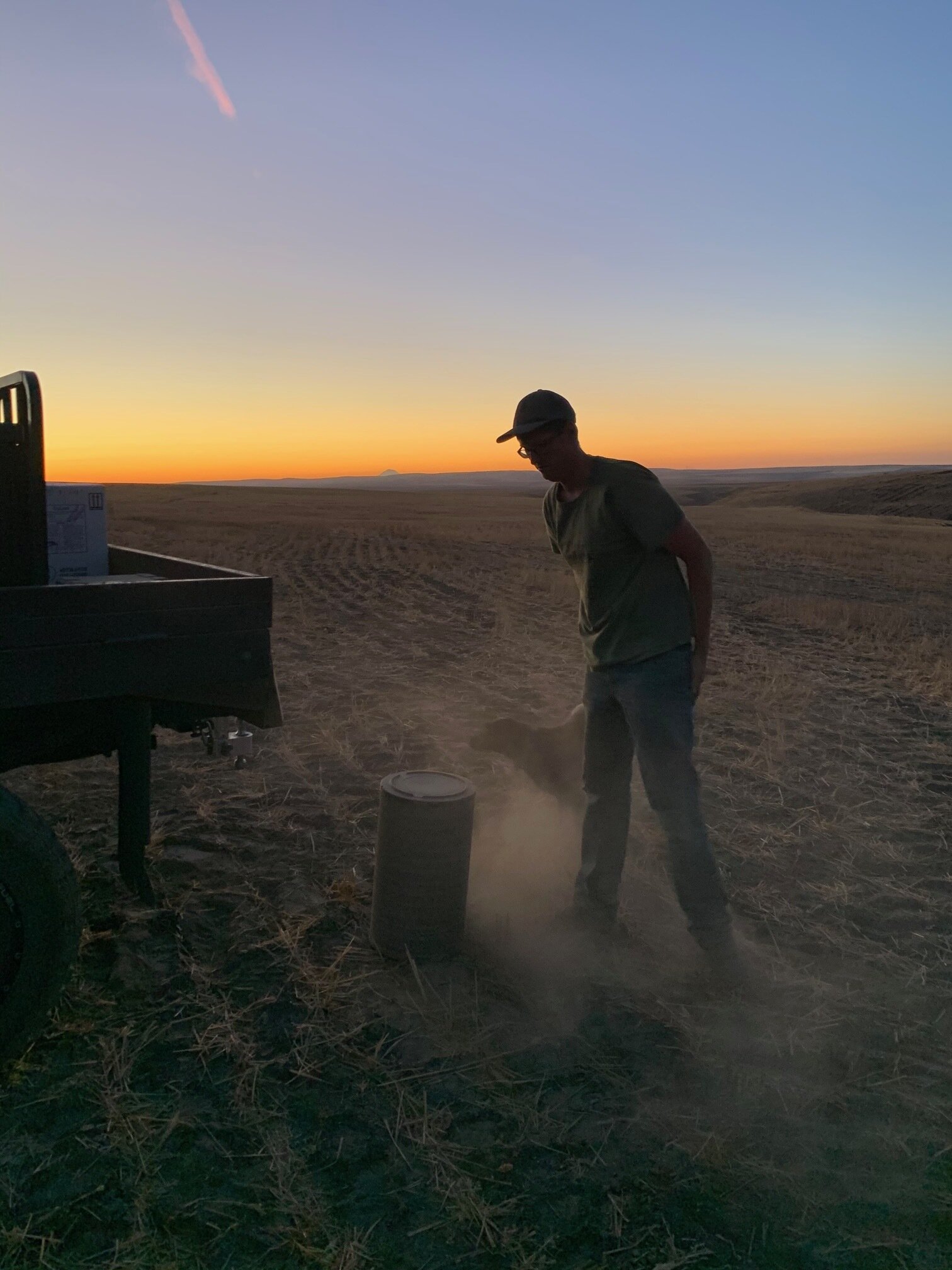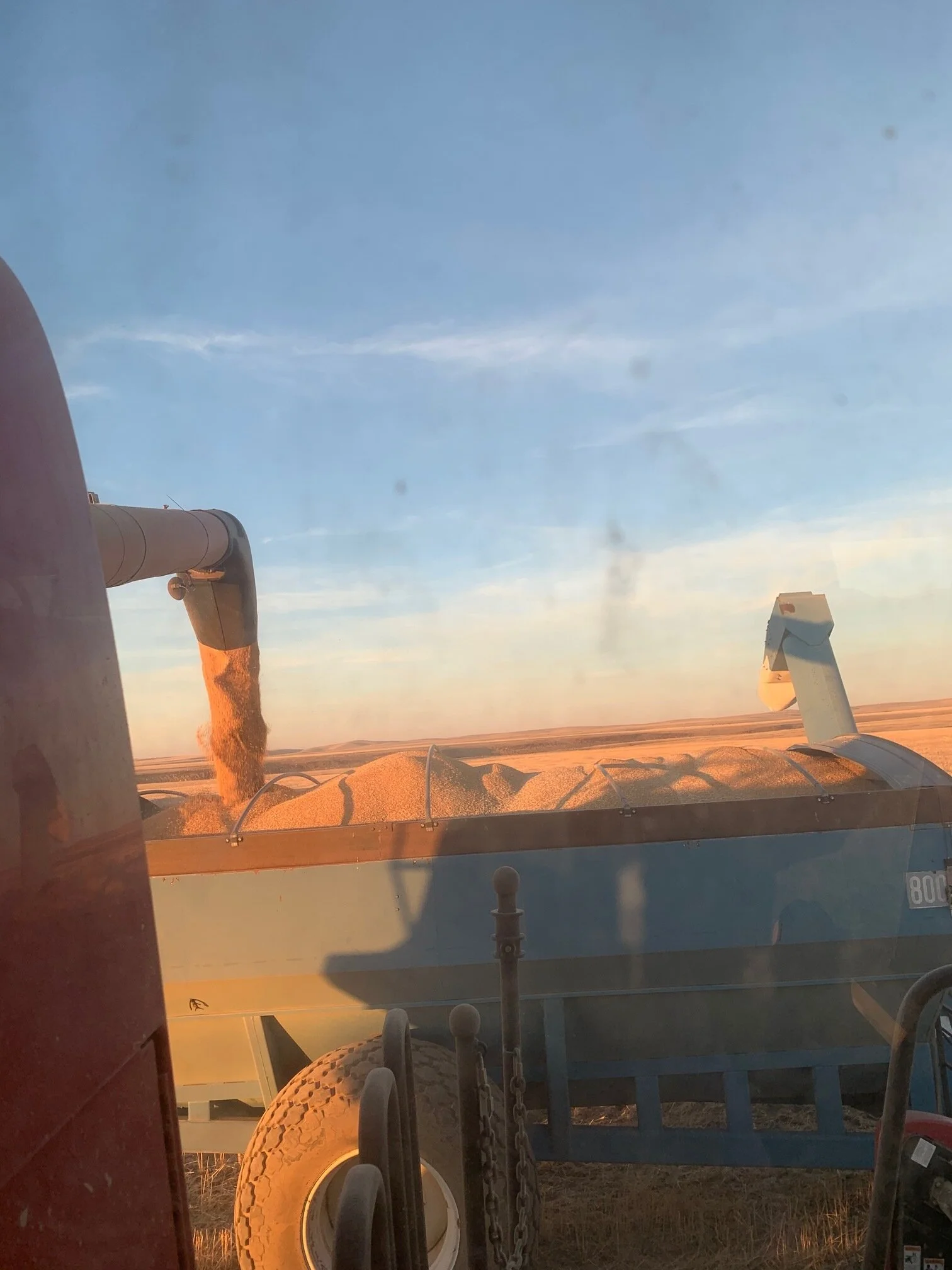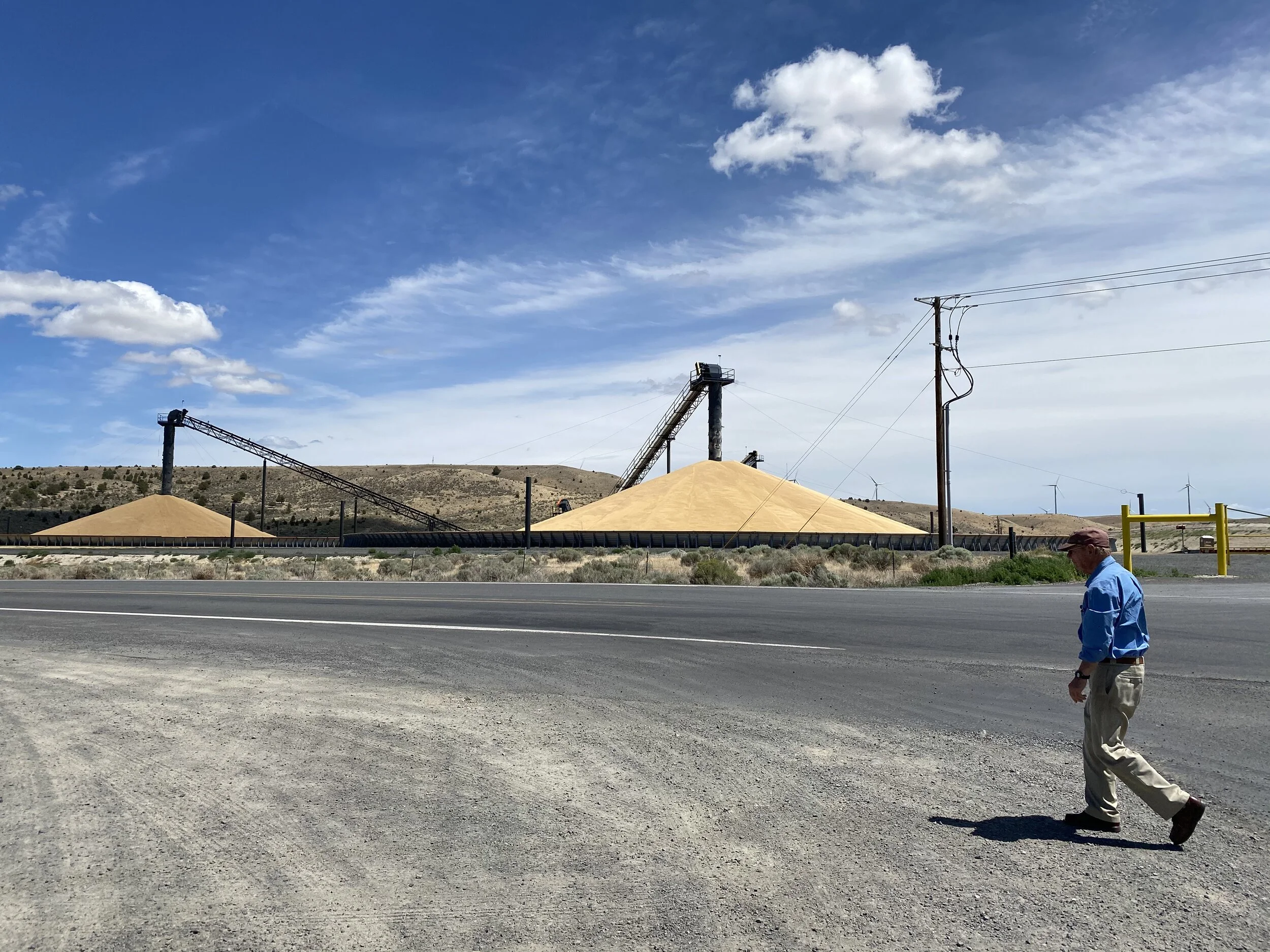Rain brings yields, quality but not price
Joe Rietmann was one of the earliest to start soft white wheat harvest in our region, cutting this field near Ione in early July. Donna, his wife, is pulling the bankout wagon.
By Tom Peterson
Farmers, generally, are above average.
On quality and yields of soft white wheat, that is.
From Morrow through Wasco counties, growers say they had a great year for quality and were either average or above expectations on yields.
The annual harvest is a major cash crop for the four-county area including Gilliam and Sherman counties, which produces close to half of the 44 million bushels of soft white wheat in Oregon.
And that’s a lot of kernels to collect.
Benjamin Rietmann cleans a combine air filter near Condon earlier this month. Gilliam County was like others in our region with average or above average yields and good quality. Several farmers in the area reported crops at 40 plus bushels per acre. Photo by Katie Cook
“Our yields were above average,” said Chris Kaseberg who farms with wife Carrie north of Wasco. “We’re really pleased, considering the total rainfall we got. The late May rain’s timing was perfect. It would be a different story had we not got that rain… It meant millions of dollars to the economy. When I talked to my Chevy dealer, he said he might sell some pickups this year.”
The marketing of wheat is a major economic engine that turns goods and services in our area. Better yet, it feeds the masses. A single bushel of wheat can produce around 42 pounds of flour or 60 loaves of bread. So 20 million bushels? - That’s some 50 billion loaves of bread.
Bankout wagons are busy in the Pacific Northwest as average and above average crops are coming in from Oregon, Washington and Idaho. Photo by Katie Cook.
Yields and Quality
In Wasco County, yields were in the high 60s to 70 plus bushels per acre.
“Wheat plants got stressed,” said Charlie Remington who harvested some 2000 acres this summer east of The Dalles. A dry spring was buoyed by a May rain, and it was “remarkable how the wheat bounced back,” Remington said. “I thought it was done.”
"Yields were really mixed,” said David Brewer of Emerson Dell Farms. Later maturing varieties of wheat likely were helped by the late rain. “Most years, early varieties are a good bet,” he said. “It’s a year where varieties mattered and any moisture lost due to the loss of residue or extended cover crop growth after the 2018 fires really hurt.”
Tom Rietmann in Gilliam County reported excellent quality and good yields. “We finished the first week of August. Crop was excellent. Waiting for grades and total bushels from Mid Columbia Producers (MCP). Protein was around 9 percent. Yields in the 40s and some 50s.”
Earl Anderson said he helped cut some fields that went 45 bushels per acre in Gilliam County.
“Crops thus far have done far better than I would have thought they were going to do when looking at them last May,” he said. “They were looking rough. The late rains really saved them.”
Morrow county also posted good yields with some of the best fields bringing 55 plus bushels per acre.
Sherman County saw production ranging from the 70s on its northern side to 40s to the south. Averages for the county likely came in around 50 to 55 bushels per acre, said Justin Miller, wheat merchandiser with Mid Columbia Producers in Moro.
Mid Columbia Producers are piling wheat south of Arlington at Cedar Springs. Coops can pile millions of bushels on the ground in years when inexpensive storage is needed.
Supply and Demand
Soft White Wheat was fetching $5.30 a bushel in Portland this morning, Aug. 26, 2020- which is off about 70 cents from May - a pretty big reduction.
So why?
Grain buyers around the Pacific Northwest (PNW) are piling millions of bushels on the ground as both Washington and Idaho are coming in with high production. Miller said the expected yield for the PNW was around 240 million bushels. Elevator operators are pushing as much wheat to Portland by barge as they can to make room.
The Pacific Northwest as a whole, especially north and east of us in Washington are seeing a large crop,” Miller said. “I heard a report from a producer near Lewiston- cutting 150 percent of average.”
At the same time, export sales out of Portland have yet to bump the price.
“China is freezing us out,” Miller said, noting the country is busy buying corn and soybeans out of Portland. “Wheat is taking a back seat.”
He speculated the country might come in for a buy in November. But he said other players could come into the market and bring the price up.
Oregon State University Extension Agent Jacob Powell agreed.
“We’re left on the sidelines,” he said. “We’re kind of that kid at recess that nobody wants to put on their team.”
Miller said the price could easily jump with a “surprise sell,” noting swing buyers - countries in the Pacific Rim might make a purchase. They buy in million-bushel contracts.
“An extra ship or two out of Portland can make a difference,” he said.
Powell and Miller both speculated prices could rise in October and or November.
Larry Wingo with Mid Columbia Producers watches as they load a 120,000 bushels of wheat on this Shaver Barge in The port of The Dalles earlier this month. Elevator operators have been hopping as soft white wheat has been pouring in. The Dalles Terminal Operator Cody Darnielle said they set a new record this year, taking in 159 truck loads of wheat in a single day. Then he woke up the next day and did it again. Mid Columbia Producers have capacity for 1.7 million bushels at their facility in The Dalles.
More on devaluation
Miller also pointed out that the price difference between red wheat in Chicago and soft white wheat in Portland has gone to zero, meaning they are getting the same price - it’s the first time to do so since 2010, he said.
Soft white wheat usually garners a higher price as it is sought for its low protein in making specialty foods such as noodles and crackers. A year ago, soft white wheat was drawing a dollar more than hard red in Chicago.
“It’s a strange year,” he said.
Plump Kernels / Great Quality
Farmers around the region are reporting that grade-one wheat is coming in at an above-average weight of 60 pounds per bushel - meaning better quality. Weights per bushel are between 61 ½ to 62 pounds, Miller said.
Heavier wheat leads to more flour per bushel, said Amanda Hoey, Chief Executive Officer with Oregon Wheat Growers League. And that makes it easier to market to other countries as they are getting more bang for their buck.
“Kernel size test weights across the board are comparable and better than 2019,” she said, noting some of the biggest customers and relationships they maintain are in Japan, Korea, Indonesia, Philippines and Yemen.
Operators at the Kortge Wheat and Cattle Co. on property at the end of Lambert Lane just outside The Dalles cut a nice stand starting on July 13, 2020.
2019 Snow Storm
In dry land farming, fields are left to sit an entire year without crops or lay fallow in order to charge the ground with enough water to make a healthy crop in the following year. A major snowstorm in February of 2019 supported this year’s crop, providing enough water especially before the rains came In May.
OSU Extension Agent Jacob Powell
Stripe Rust
Oregon State University Extension Agent Jacob Powell in The Dalles said farmers worked hard this spring to fight off stripe rust, noting it affected the wheat variety of Magic the most. The variety developed by the University of Idaho and Colorado company Limagrain Cereal Seeds is sold as resistant to Beyond herbicide. The enzyme in the herbicide is sprayed on broadleaf weeds and inhibits the plant's growth, eventually killing it.
Miller said the rust was caught early and farmers used one or two applications of fungicide to keep it from affecting yields much.







